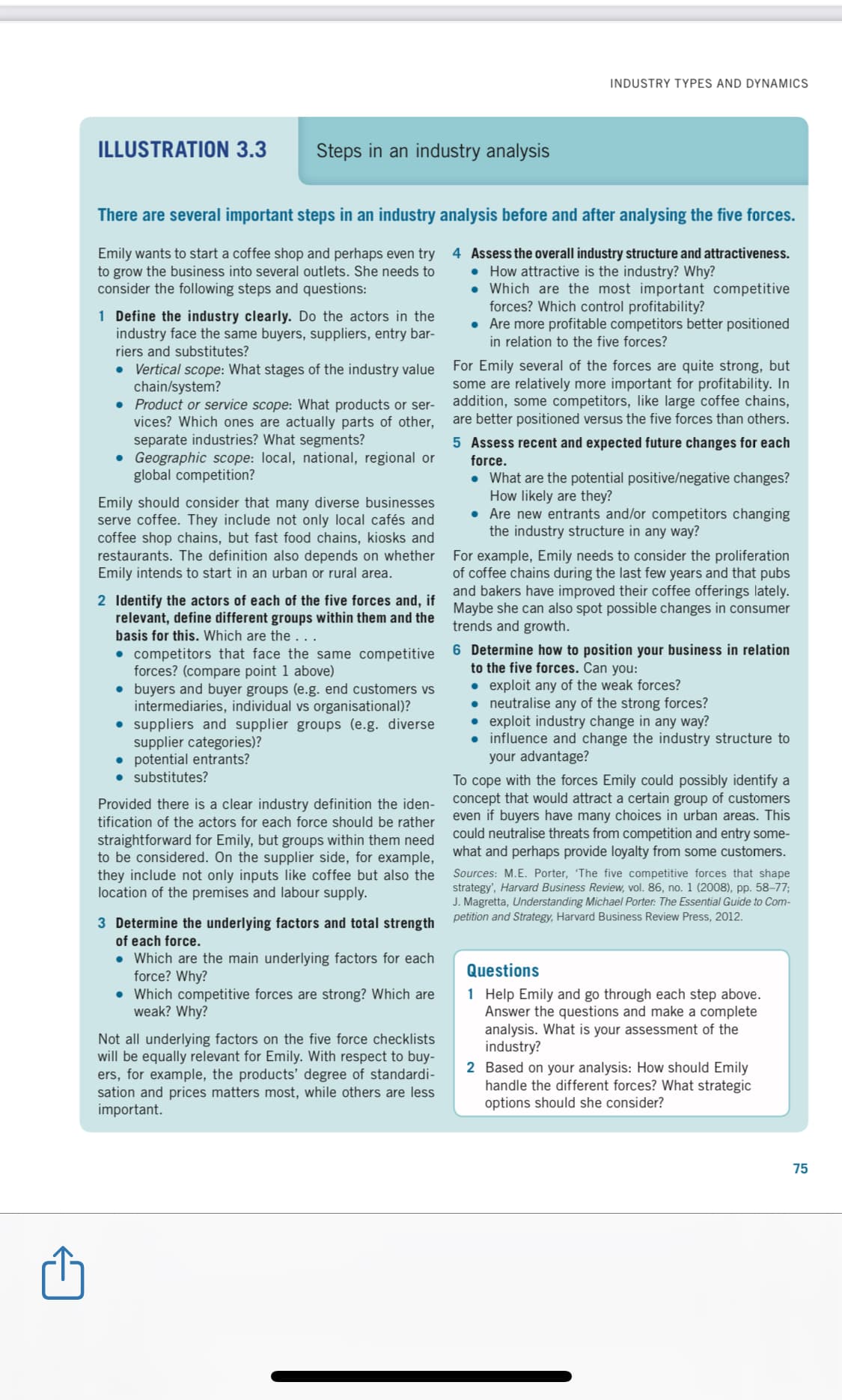Help Emily and go through each step above. Answer the questions and make a complete analysis. What is your assessment of the industry? Based on your analysis: How should Emily handle the different forces? What strategic options should she consider?
Help Emily and go through each step above. Answer the questions and make a complete analysis. What is your assessment of the industry? Based on your analysis: How should Emily handle the different forces? What strategic options should she consider?
Purchasing and Supply Chain Management
6th Edition
ISBN:9781285869681
Author:Robert M. Monczka, Robert B. Handfield, Larry C. Giunipero, James L. Patterson
Publisher:Robert M. Monczka, Robert B. Handfield, Larry C. Giunipero, James L. Patterson
Chapter6: Category Strategy Development
Section: Chapter Questions
Problem 1DQ
Related questions
Question

Transcribed Image Text:INDUSTRY TYPES AND DYNAMICS
ILLUSTRATION 3.3
Steps in an industry analysis
There are several important steps
an industry analysis before and after analysing the five forces.
Emily wants to start a coffee shop and perhaps even try 4 Assess the overall industry structure and attractiveness.
to grow the business into several outlets. She needs to
consider the following steps and questions:
• How attractive is the industry? Why?
• Which are the most important competitive
forces? Which control profitability?
• Are more profitable competitors better positioned
in relation to the five forces?
1 Define the industry clearly. Do the actors in the
industry face the same buyers, suppliers, entry bar-
riers and substitutes?
• Vertical scope: What stages of the industry value
chain/system?
• Product or service scope: What products or ser-
vices? Which ones are actually parts of other,
separate industries? What segments?
• Geographic scope: local, national, regional or
global competition?
For Emily several of the forces are quite strong, but
some are relatively more important for profitability. In
addition, some competitors, like large coffee chains,
are better positioned versus the five forces than others.
5 Assess recent and expected future changes for each
force.
Emily should consider that many diverse businesses
serve coffee. They include not only local cafés and
coffee shop chains, but fast food chains, kiosks and
restaurants. The definition also depends on whether
Emily intends to start in an urban or rural area.
• What are the potential positive/negative changes?
How likely are they?
• Are new entrants and/or competitors changing
the industry structure in any way?
For example, Emily needs to consider the proliferation
of coffee chains during the last few years and that pubs
and bakers have improved their coffee offerings lately.
Maybe she can also spot possible changes in consumer
trends and growth.
2 Identify the actors of each of the five forces and, if
relevant, define different groups within them and the
basis for this. Which are the
• competitors that face the same competitive 6 Determine how to position your business in relation
forces? (compare point 1 above)
• buyers and buyer groups (e.g. end customers vs
intermediaries, individual vs organisational)?
• suppliers and supplier groups (e.g. diverse
supplier categories)?
• potential entrants?
• substitutes?
to the five forces. Can you:
• exploit any of the weak forces?
• neutralise any of the strong forces?
• exploit industry change in any way?
• influence and change the industry structure to
your advantage?
To cope with the forces Emily could possibly identify a
concept that would attract a certain group of customers
even if buyers have many choices in urban areas. This
could neutralise threats from competition and entry some-
what and perhaps provide loyalty from some customers.
Provided there is a clear industry definition the iden-
tification of the actors for each force should be rather
straightforward for Emily, but groups within them need
to be considered. On the supplier side, for example,
they include not only inputs like coffee but also the
location of the premises and labour supply.
Sources: M.E. Porter, 'The five competitive forces that shape
strategy', Harvard Business Review, vol. 86, no. 1 (2008), pp. 58–77;
J. Magretta, Understanding Michael Porter: The Essential Guide to Com-
3 Determine the underlying factors and total strength petition and Strategy, Harvard Business Review Press, 2012.
of each force.
• Which are the main underlying factors for each
force? Why?
• Which competitive forces are strong? Which are
weak? Why?
Questions
1 Help Emily and go through each step above.
Answer the questions and make a complete
analysis. What is your assessment of the
industry?
Not all underlying factors on the five force checklists
will be equally relevant for Emily. With respect to buy-
ers, for example, the products' degree of standardi-
sation and prices matters most, while others are less
important.
2 Based on your analysis: How should Emily
handle the different forces? What strategic
options should she consider?
75
Expert Solution
This question has been solved!
Explore an expertly crafted, step-by-step solution for a thorough understanding of key concepts.
Step by step
Solved in 3 steps

Recommended textbooks for you

Purchasing and Supply Chain Management
Operations Management
ISBN:
9781285869681
Author:
Robert M. Monczka, Robert B. Handfield, Larry C. Giunipero, James L. Patterson
Publisher:
Cengage Learning

Purchasing and Supply Chain Management
Operations Management
ISBN:
9781285869681
Author:
Robert M. Monczka, Robert B. Handfield, Larry C. Giunipero, James L. Patterson
Publisher:
Cengage Learning